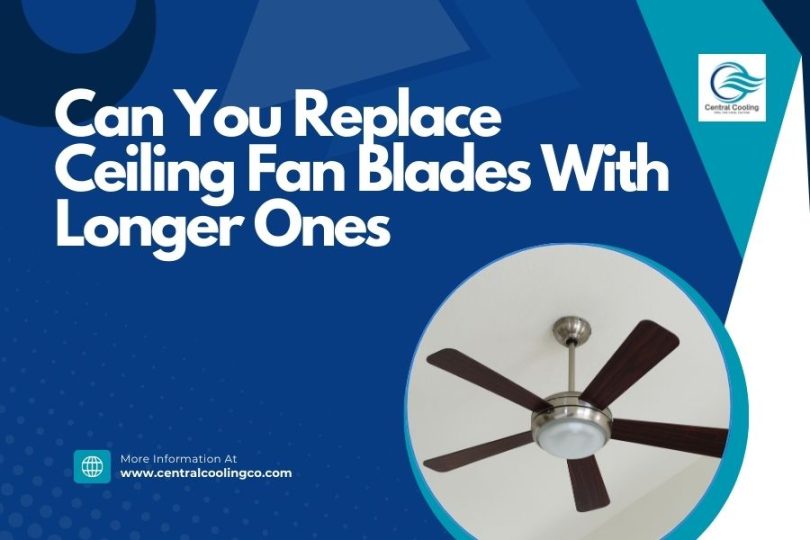If you’ve ever wondered whether replacing your ceiling fan blades with longer ones can enhance airflow, you’re not alone. Many homeowners consider this modification to improve the comfort and efficiency of their living spaces. In this guide, we consult domestic setup experts to explore the possibilities and limitations of altering ceiling fan blades, providing you with the necessary insights to make an informed decision.
Ceiling fans play a crucial role in maintaining indoor air circulation. Still, upgrading to longer blades raises important questions about feasibility and safety. By examining expert advice and technical considerations, this guide aims to help you understand the potential benefits and challenges of replacing your ceiling fan blades, ensuring you achieve optimal performance without compromising safety.
Can You Replace Ceiling Fan Blades?
While replacing ceiling fan blades might seem appealing, it’s crucial to understand the limitations. Ceiling fan blades can be replaced, but they should ideally be the same size as the original ones. The fan motor is designed to handle a specific blade size, and altering it can lead to complications, such as motor burnout.
Benefits Of Replacing Ceiling Fan Blades With Longer Ones
Improved Air Circulation: Longer blades can move more air, benefiting larger rooms or areas with higher ceilings. This can enhance comfort by improving the distribution of cool or warm air.
Aesthetic Appeal: Longer blades give the fan a more substantial and elegant look, which suits certain interior design styles better.
Energy Efficiency: In some cases, longer blades can circulate air more effectively at lower speeds, potentially reducing energy consumption.
Potential Issues and Considerations When Replacing Ceiling Fan Blades with Longer Ones
Motor Capacity: Ceiling fans have specific motor capacities to handle a certain blade length and weight. Installing longer blades can overload the motor, leading to overheating, reduced lifespan, or even motor failure. Ensuring the fan’s motor can handle the increased load is essential.
Balance and Stability: The fan’s design ensures the blades are balanced. Changing the blade length can disrupt this balance, leading to wobbling, noise, and increased wear on the motor and bearings. Ensuring that the blades are balanced after replacement is crucial.
Mounting and Clearance: Longer blades require more space. Ensure enough clearance from walls, ceilings, and other obstacles to avoid collisions, which can damage the fan and the surroundings. The fan should also be securely mounted to handle the increased stress.
Safety Regulations: Modifying a ceiling fan can void warranties and may not comply with safety standards or building codes. It is important to consider these factors before proceeding with any modifications.
Steps To Replace Ceiling Fan Blades With Longer Ones
If you still wish to proceed with replacing your ceiling fan blades, here’s a step-by-step guide:
– Use a ladder or step stool to access the fan blades easily.
– Ensure the blades are clean to prevent dirt from entering during the replacement process.
– Remove each blade using a screwdriver, usually attached to the fan housing with screws.
– If changing the look of your fan, ensure compatibility with the new bracket.
– Securely screw the new blades into the existing frame one by one.
– Turn on the fan and check for any wobbling to ensure stability.
Detailed Considerations For Replacing Ceiling Fan Blades
To delve deeper into the technical and practical aspects of replacing ceiling fan blades with longer ones, let’s explore some specific areas in more detail.
Motor Capacity And Specifications
The motor is the heart of a ceiling fan, and its capacity is tailored to handle specific blade sizes and weights. Overloading the motor by installing longer blades can cause several issues:
Overheating: An overburdened motor generates more heat, leading to overheating and potentially damaging internal components or even causing a fire hazard.
Reduced Efficiency: A motor struggling with longer blades will operate less efficiently, increasing energy consumption and utility bills.
Shortened Lifespan: Continuous strain on the motor can significantly reduce its operational lifespan, leading to frequent breakdowns and the need for costly repairs or replacements.
Before proceeding, consult the fan’s manufacturer or refer to the product manual to ensure compatibility with longer blades. If the motor isn’t designed to support the added length and weight, it’s best not to proceed with the modification.
Balancing And Stability
When you replace the fan blades, maintaining balance is critical to prevent wobbling and ensure smooth operation. Here’s how to achieve proper balance:
Blade Alignment: Ensure all blades are aligned at the same angle and distance from the motor. Misalignment can cause uneven air distribution and increase wobble.
Blade Weight: Each blade should have the same weight. Use a balancing kit, which typically includes a clip and weights to adjust the balance by attaching weights to the lighter blade until the fan operates smoothly.
Mounting Hardware: Use the original mounting hardware, if possible, as it is designed to fit the blades and motor. Ensure all screws and bolts are tightly secured to avoid any movement during operation.
Mounting And Clearance
Longer blades require additional space to operate safely. Consider the following:
Ceiling Height: Ensure there is adequate clearance from the ceiling. A minimum of 7 feet from the floor to the blade tips is generally recommended for safety.
Wall Clearance: Ensure that the blades do not come into contact with walls or other obstacles. A minimum clearance of 18 inches from the walls is recommended.
Fixture Stability: The fan’s mounting bracket must be securely attached to a ceiling joist or other structural support to handle the increased load. Use heavy-duty brackets if necessary.
For guidance on iinstalling a ceiling fan on a vaulted ceiling, check our detailed guide
Safety Regulations And Compliance
Modifying a ceiling fan can impact its compliance with safety regulations and standards. Consider:
Warranty: Modifying the fan may void the manufacturer’s warranty, leaving you responsible for future repairs or replacements.
Building Codes: Ensure the modification complies with local building codes and electrical safety standards. Non-compliance can lead to fines or issues during property inspections.
Insurance: Check with your home insurance provider to understand how modifications might affect your coverage. Unauthorized modifications could void your policy in case of a claim related to the fan.
Alternative Solutions To Enhance Airflow Without Longer Blades
If replacing the blades with longer ones seems too risky or complicated, consider these alternatives:
Adjust Fan Settings: If the goal is to improve air circulation, try adjusting the fan’s speed settings or reversing the direction of rotation. This can enhance airflow without the need for modifications.
Install Additional Fans: In larger rooms, multiple fans can provide better air circulation than modifying a single fan. This approach also distributes the load and reduces the risk of motor strain.
Upgrade to a Larger Fan: If longer blades are necessary, consider replacing the entire fan with a larger model designed for greater blade length and air circulation. This ensures that the motor and other components are appropriately matched to the blade size.
Factors Influencing Airflow In Ceiling Fans
Ceiling fans are designed with several factors that influence their ability to move air effectively. Understanding these factors can help you optimize the performance of your fan:
Blade Pitch: The blades’ angle, or pitch, significantly affects how much air a ceiling fan can move. Blades with a steeper pitch (typically between 12 to 15 degrees) are more effective at pushing air downwards or upwards, depending on the fan’s direction. This pitch allows the fan to move more air with each rotation, enhancing airflow.
Blade Size and Length: The size and length of the blades also play a crucial role. Longer blades generally move more air than shorter ones because they cover a larger area. However, it’s important to ensure the motor can handle the increased load of longer and possibly heavier blades without overheating or strain.
Blade Material and Design: The material and design of the blades affect their aerodynamic properties. Blades made from wood, plastic, or metal can impact how efficiently the fan moves air. Additionally, some blades are designed with aerodynamic shapes or winglets to reduce drag and improve airflow performance.
Motor Power and Efficiency: The ceiling fan’s motor is the engine that drives the blades. A more powerful motor can handle larger blades and higher blade pitches more effectively, resulting in better airflow. Look for fans with Energy Star ratings or high CFM (Cubic Feet per Minute) ratings, which indicate better energy efficiency and airflow performance.
Fan Speed and Control: The fan blades’ rotation speed affects airflow. Most ceiling fans have multiple speed settings that allow you to adjust the airflow according to your comfort needs. Higher speeds typically move more air but may also generate more noise and consume more energy.
Room Size and Ceiling Height: The size of the room and height are important considerations for ceiling fan performance. Larger rooms may require fans with larger blades or higher CFM ratings to circulate air effectively. Ceiling height can also affect air distribution, with taller ceilings requiring fans designed to push air downward effectively.
Installation and Mounting: Proper installation and mounting of the ceiling fan are crucial for optimal airflow. Ensure the fan is securely mounted to minimize wobbling, which can disrupt airflow and cause noise. Proper clearance from walls and other obstacles is also important to avoid airflow obstruction.
Understanding these factors allows you to choose a ceiling fan that complements your room’s aesthetics and provides efficient airflow throughout the year. Whether you want to improve cooling during summer or enhance air circulation in winter, selecting a fan with the right blade pitch, size, and motor power ensures optimal performance and energy efficiency.
Why Changing Blade Size Is Generally A Bad Idea
If the motor can manage the extra weight, you can replace ceiling fan blades with longer ones. However, larger blades may overload the engine, causing it to slow down and potentially burn out. Even if the motor can handle the weight, the impact on airflow is minimal. The motor controls the airflow, and changing the blades might not significantly improve the cooling power.
Frequently Asked Questions
Can I Put Shorter Blades On A Ceiling Fan?
Putting shorter blades on a ceiling fan may not be practical. Shorter blades must spin faster to maintain airflow, which doesn’t necessarily enhance cooling power. Additionally, using blades of uneven length can lead to an unbalanced fan, affecting its performance.
Are Replacement Ceiling Fan Blades Universal?
Replacement blades for ceiling fans come in various sizes, patterns, and weights. It’s advisable to find replacements from the same manufacturer to ensure compatibility. Experimenting with different blades may misalign the existing brackets, affecting the fan’s overall performance.
Can Replacing Ceiling Fan Blades Affect Its Warranty?
Modifying a ceiling fan, including replacing blades with longer ones, can void the manufacturer’s warranty. It’s important to check the warranty terms and consider the implications before proceeding with any alterations to ensure coverage for future repairs or replacements.
Conclusion
Replacing ceiling fan blades with longer ones is a complex task that requires careful consideration of motor capacity, balance, clearance, and safety regulations. While the potential benefits include improved air circulation and enhanced aesthetics, the risks associated with motor strain, imbalance, and non-compliance with safety standards can outweigh these benefits. By carefully evaluating the fan’s specifications, ensuring proper installation, and considering alternative solutions, you can make an informed decision that balances performance, safety, and aesthetics. If in doubt, consulting with a professional or opting for a fan upgrade might be the best action.
Disclosure: We may get commissions for purchases made through links in this post.








